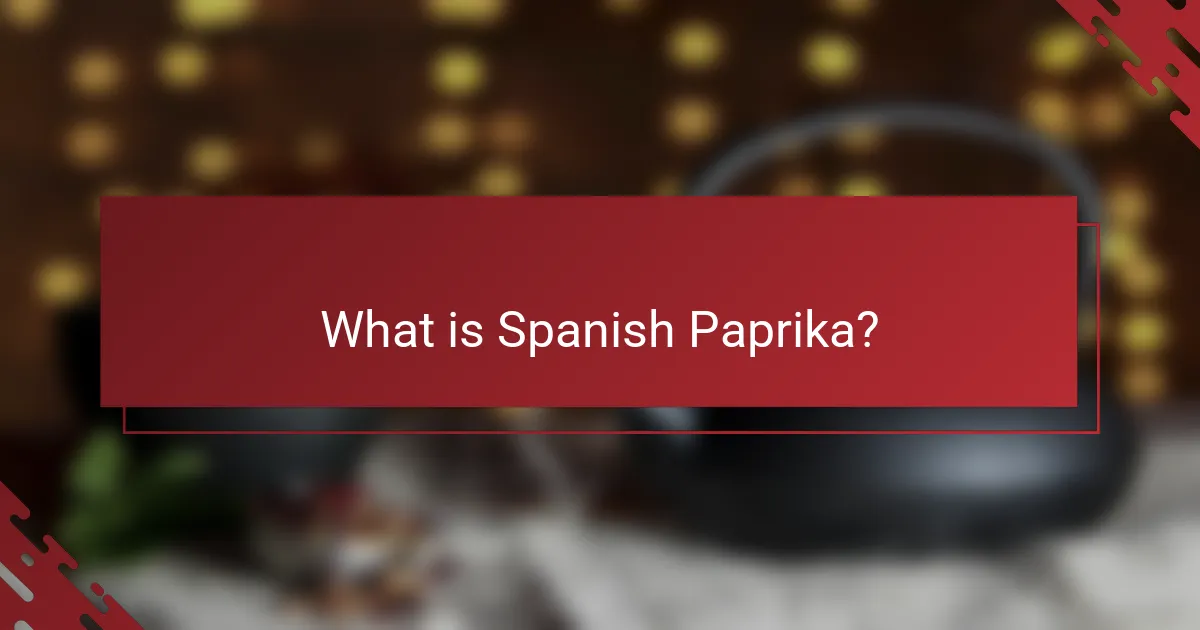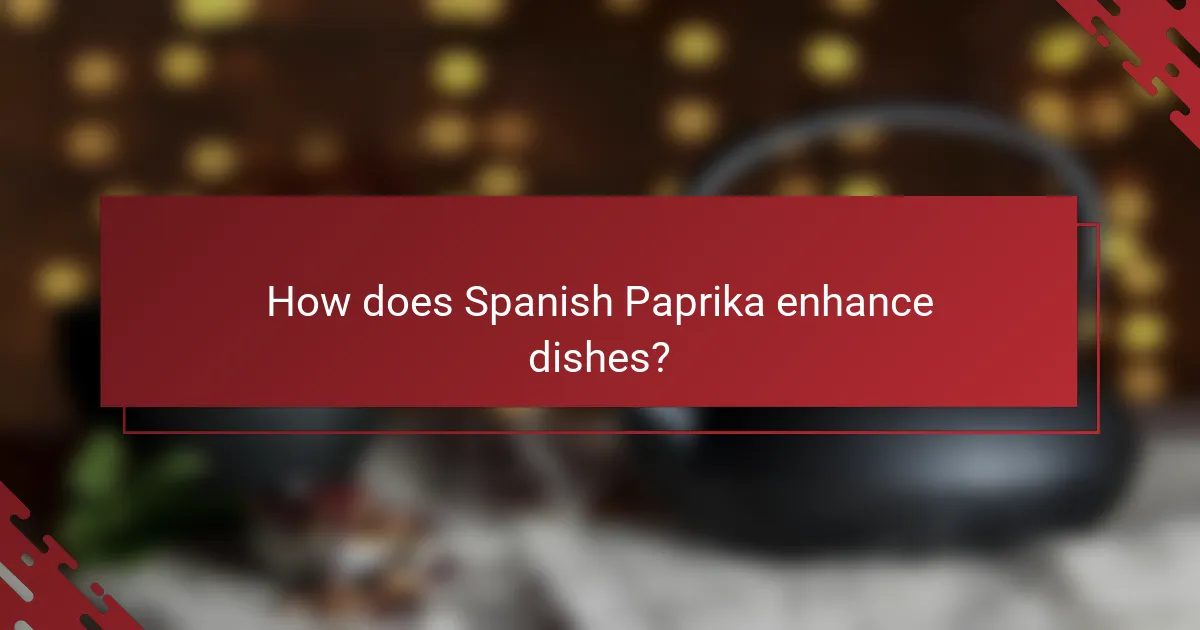Spanish paprika is a ground spice derived from dried red peppers, specifically from the Capsicum annuum variety, and serves as a fundamental component of Spanish cuisine. This spice varies in flavor intensity, with types including dulce (sweet), picante (spicy), and agridulce (bittersweet), each contributing unique taste profiles to dishes such as paella and chorizo. Spanish paprika not only enhances culinary creations with its vibrant red color but also offers potential health benefits due to its antioxidant properties. Authentic Spanish paprika, particularly “Pimentón de la Vera,” is characterized by its freshness and quality, which can be preserved through proper storage techniques.

What is Spanish Paprika?
Spanish paprika is a ground spice made from dried red peppers. It is a key ingredient in Spanish cuisine. The peppers used for this paprika are typically from the Capsicum annuum variety. Spanish paprika can vary in flavor intensity, ranging from sweet to smoky. It is often used to enhance the taste of dishes like paella and chorizo. The spice comes in different types, including dulce (sweet), picante (spicy), and agridulce (bittersweet). Spanish paprika has a rich history, dating back to the 16th century when it was introduced to Europe from the Americas. Its vibrant color and distinctive flavor make it a staple in many kitchens.
How is Spanish Paprika made?
Spanish paprika is made from grinding dried peppers, specifically Capsicum annuum varieties. The process begins with harvesting the peppers at their peak ripeness. After harvesting, the peppers are sun-dried or smoked, depending on the desired flavor profile. The drying process can take several weeks and enhances the peppers’ natural sweetness. Once dried, the peppers are ground into a fine powder. The grinding process can vary in texture, resulting in different paprika types. Spanish paprika can be sweet, bittersweet, or hot, depending on the pepper variety used. This versatility makes it a staple in Spanish cuisine, used in dishes like paella and chorizo.
What types of peppers are used in Spanish Paprika production?
Spanish paprika production primarily uses three types of peppers: Pimiento de la Vera, Pimiento del Cayenne, and Pimiento Morron. Pimiento de la Vera is known for its smoky flavor, as it is traditionally dried over oak wood. Pimiento del Cayenne offers a spicier profile and is often used for its heat. Pimiento Morron is sweeter and milder, contributing a different taste dimension. These peppers are essential to the distinct flavors of Spanish paprika.
What is the drying process for Spanish Paprika?
The drying process for Spanish paprika involves air-drying the peppers. This process typically takes place in the open air under the sun. The peppers are harvested when fully ripe. After harvesting, they are hung in clusters to dry. This drying method can take several weeks. The traditional method enhances the flavor and color of the paprika. Once dried, the peppers are ground into a fine powder. This powder is then packaged for use in cooking.
What are the different types of Spanish Paprika?
The different types of Spanish paprika are Pimentón de la Vera, Pimentón dulce, Pimentón picante, and Pimentón agridulce. Pimentón de la Vera is known for its smoky flavor, derived from drying peppers over oak wood. Pimentón dulce is the sweet variety, offering a mild flavor. Pimentón picante is the hot version, providing a spicy kick. Pimentón agridulce combines sweet and spicy notes, making it versatile for various dishes. Each type is made from specific pepper varieties and has unique culinary uses in Spanish cuisine.
What distinguishes sweet paprika from hot paprika?
Sweet paprika is characterized by its mild flavor and sweetness, while hot paprika has a spicier, more pungent taste. The distinction lies primarily in the types of peppers used. Sweet paprika is made from sweeter varieties, such as Capsicum annuum. Hot paprika, on the other hand, is derived from spicier varieties of the same species. This difference in pepper selection results in varying flavor profiles. Additionally, sweet paprika often has a vibrant red color, whereas hot paprika may appear slightly darker. The Scoville heat units also differ; sweet paprika typically scores 0-100 SHU, while hot paprika can range from 100-1000 SHU. These attributes make sweet paprika ideal for seasoning without heat, while hot paprika adds spice to dishes.
How does smoked paprika differ from other types?
Smoked paprika differs from other types primarily due to its unique flavor profile. It is made from peppers that are dried over an oak fire, which imparts a distinct smoky taste. Other types of paprika, such as sweet or hot, are typically made from sun-dried peppers and do not undergo this smoking process. This smoking method enhances the depth of flavor in smoked paprika, making it richer and more complex. Additionally, smoked paprika often has a darker red color compared to its non-smoked counterparts. The specific variety of pepper used can also influence the flavor intensity, but the smoking process is the defining characteristic that sets it apart.
What flavor profiles can be found in Spanish Paprika?
Spanish paprika exhibits a range of flavor profiles, primarily including sweet, smoky, and slightly bitter notes. The sweetness comes from the Capsicum annuum peppers used in its production. The smoky flavor is characteristic of varieties like pimentón de la Vera, which undergo a drying process over oak wood. Additionally, some types may present a mild spiciness, depending on the specific pepper used. The complexity of these flavors allows Spanish paprika to enhance various dishes, from stews to meats. The distinct profiles are a result of traditional cultivation and processing methods in Spain, contributing to its culinary significance.
What are the taste characteristics of sweet paprika?
Sweet paprika has a mild, sweet flavor profile. It lacks the heat found in other paprika types. The taste is often described as fruity and slightly earthy. Sweet paprika can enhance dishes without overpowering them. Its flavor is commonly used in Spanish cuisine. It adds color and a subtle depth to recipes. Sweet paprika is also known for its aromatic qualities. It is a staple in dishes like paella and goulash.
How does the intensity of hot paprika compare to other varieties?
Hot paprika is generally more intense than sweet paprika but less intense than cayenne pepper. The Scoville heat unit (SHU) rating for hot paprika typically ranges from 1000 to 1500 SHU. In contrast, sweet paprika usually falls between 0 to 500 SHU. Cayenne pepper, known for its heat, can reach 30,000 to 50,000 SHU. Therefore, hot paprika provides a moderate level of heat suitable for various dishes without overwhelming the palate.

How does Spanish Paprika enhance dishes?
Spanish paprika enhances dishes by adding rich flavor and vibrant color. It comes in various types, including sweet, smoked, and hot. Each type contributes unique taste profiles. Sweet paprika provides a mild, sweet flavor, while smoked paprika adds a deep, smoky essence. Hot paprika delivers a spicy kick. The vibrant red color of paprika also visually enhances dishes. Studies show that paprika contains antioxidants, which can contribute to health benefits. Its versatility allows it to be used in various cuisines, from stews to sauces. This adaptability makes it a staple in many recipes.
What are common culinary applications for Spanish Paprika?
Spanish Paprika is commonly used in various culinary applications. It enhances the flavor of stews, soups, and sauces. This spice is essential in traditional dishes like paella and chorizo. It also adds color and depth to rice and vegetable dishes. Spanish Paprika is often used as a seasoning for meats and fish. Additionally, it can be sprinkled on deviled eggs or used in salad dressings. Its smoky variety is particularly popular for grilling. Overall, Spanish Paprika is versatile and widely utilized in Mediterranean and Spanish cuisines.
How is Spanish Paprika used in traditional Spanish dishes?
Spanish paprika is a key ingredient in traditional Spanish dishes. It adds depth and flavor to various recipes. Commonly, it is used in stews like pisto and paella. Spanish paprika enhances the taste of chorizo, giving it a distinct smoky flavor. It is also sprinkled on dishes like patatas bravas for added spice. In addition to savory dishes, it is used in sauces such as romesco. Spanish paprika can be sweet or hot, allowing versatility in cooking. Its historical use dates back to the 16th century, making it an integral part of Spanish cuisine.
What modern recipes incorporate Spanish Paprika?
Modern recipes that incorporate Spanish Paprika include dishes like paella, chorizo stew, and roasted vegetables. Paella often features this spice to enhance its flavor profile. Chorizo stew uses Spanish Paprika to add depth and warmth. Roasted vegetables gain a smoky note when seasoned with this paprika. Additionally, Spanish Paprika is used in marinades for meats and seafood. It can also be found in soups and sauces, providing a rich color and taste. These applications highlight the versatility of Spanish Paprika in contemporary cooking.
Why is flavor intensity important in cooking with Spanish Paprika?
Flavor intensity is crucial in cooking with Spanish paprika because it directly influences the overall taste of a dish. Spanish paprika is available in varying intensities, such as sweet, bittersweet, and hot. The right flavor intensity enhances the balance of flavors in recipes. For instance, sweet paprika adds depth without overwhelming other ingredients. Conversely, hot paprika introduces a spicy kick that can elevate a dish’s profile. Understanding the intensity allows for precise seasoning adjustments. This knowledge is essential in traditional Spanish cuisine, where paprika plays a pivotal role. Recipes often rely on paprika’s intensity to achieve authentic flavors. Thus, selecting the appropriate intensity is key to culinary success.
How does the choice of paprika affect the overall flavor of a dish?
The choice of paprika significantly influences the overall flavor of a dish. Different types of paprika, such as sweet, smoked, and hot, impart distinct flavor profiles. Sweet paprika offers a mild and slightly sweet taste, enhancing dishes without overwhelming them. Smoked paprika adds a rich, smoky flavor, ideal for imparting depth to roasted meats and stews. Hot paprika contributes heat and spiciness, elevating the flavor intensity of various recipes. The specific variety chosen can transform the dish’s character, making it more vibrant or complex. For example, traditional Spanish dishes often rely on sweet or smoked paprika for authenticity. This versatility makes paprika a crucial ingredient in achieving desired flavor outcomes.
What tips can help balance the flavor intensity of Spanish Paprika in recipes?
To balance the flavor intensity of Spanish paprika in recipes, consider using complementary ingredients. Adding dairy, such as sour cream or yogurt, can mellow the spice. Incorporating sweetness from honey or sugar can counteract the heat. Using acidic elements like lemon juice or vinegar can also provide balance. Additionally, diluting the paprika with broth or water can reduce its potency. Adjusting the quantity of paprika gradually allows for better control over flavor. Combining it with other spices can create a more complex flavor profile. These methods ensure that the paprika enhances rather than overwhelms the dish.

How can I choose and store Spanish Paprika?
To choose Spanish paprika, select a product labeled as “Pimentón de la Vera” for authenticity. Look for vibrant red color, which indicates freshness and quality. Check for a sealed container to preserve flavor. For storage, keep paprika in a cool, dark place away from heat and moisture. Airtight containers are ideal to prevent exposure to air. Properly stored, paprika can maintain its flavor for up to a year. Always check for an expiration date to ensure optimal quality.
What should I look for when selecting Spanish Paprika?
When selecting Spanish paprika, look for its color, aroma, and origin. High-quality Spanish paprika is vibrant red, indicating freshness and richness. Aroma should be strong and fragrant, reflecting the type of paprika. Verify the origin; authentic Spanish paprika comes from regions like La Vera or Murcia. Check for the specific type: smoked (pimentón ahumado) or sweet (dulce). Smoked paprika has a distinct, rich flavor due to the drying process. Sweet paprika offers a milder taste suitable for various dishes. Lastly, inspect packaging for freshness dates and quality seals to ensure you are purchasing a premium product.
How can I determine the freshness of Spanish Paprika?
To determine the freshness of Spanish Paprika, check the packaging date. Fresh paprika typically has a vibrant color, such as deep red or bright orange. Dull or faded color indicates age or loss of potency. Smell the paprika; fresh paprika has a strong, aromatic scent. A musty or weak smell suggests it is no longer fresh. Taste a small amount; fresh paprika should have a robust flavor. If the flavor is flat or bitter, it may be stale. Store paprika in a cool, dark place to maintain freshness. Proper storage extends its shelf life, typically up to three years.
What packaging options are best for preserving flavor?
Airtight containers are the best packaging options for preserving flavor. These containers prevent exposure to air, which can lead to oxidation. Glass jars with tight seals are effective at maintaining freshness. Vacuum-sealed bags also minimize air contact and moisture. Mylar bags with oxygen absorbers are another excellent choice. They protect against light and humidity, which can degrade flavor. Proper storage in a cool, dark place further enhances flavor retention. These methods are widely recommended by food preservation experts for maintaining the quality of spices like paprika.
What are the best practices for storing Spanish Paprika?
Store Spanish paprika in a cool, dark place to maintain its flavor and color. Use an airtight container to prevent exposure to air and moisture. Keep it away from heat sources like stoves and ovens. Ensure the container is opaque to block light, which can degrade the spice. Properly stored, Spanish paprika can last up to three years without losing its potency. Regularly check for any signs of spoilage, such as off smells or discoloration. These practices help preserve the quality of the spice for culinary use.
How does storage temperature affect the quality of Spanish Paprika?
Storage temperature significantly affects the quality of Spanish paprika. High temperatures can lead to the degradation of flavor and color. Heat accelerates the loss of essential oils and antioxidants. This results in a duller taste and reduced health benefits. Optimal storage temperature for paprika is around 60°F to 70°F (15°C to 21°C). At these temperatures, paprika retains its vibrant color and robust flavor. Studies indicate that storing paprika in cool, dark places extends its shelf life. Proper storage conditions are essential for maintaining the spice’s quality over time.
What is the shelf life of Spanish Paprika, and how can I maximize it?
The shelf life of Spanish paprika is typically 2 to 3 years when stored properly. To maximize its longevity, keep it in a cool, dark place. Exposure to light and heat can degrade its quality. Use an airtight container to prevent moisture and air from entering. Additionally, avoid storing it near the stove or in damp areas. Regularly check for changes in color or aroma, as these indicate loss of potency. Proper storage ensures that Spanish paprika retains its flavor and aroma for an extended period.
What are some tips for using Spanish Paprika effectively in cooking?
Use Spanish paprika to enhance flavor in various dishes. Start by adding it to soups, stews, and sauces for depth. Incorporate it into marinades for meats to infuse flavor. Use it as a finishing touch on roasted vegetables for color and taste. Combine it with olive oil to create a flavorful drizzle. Remember that Spanish paprika can lose potency over time, so store it in a cool, dark place. For best results, add it towards the end of cooking to preserve its flavor and color.
Spanish paprika is a ground spice made from dried red peppers, primarily from the Capsicum annuum variety, and is essential in Spanish cuisine. The article explores the different types of Spanish paprika, including dulce, picante, and agridulce, each with unique flavor profiles ranging from sweet to smoky. It details the production process, including the drying methods and the specific pepper varieties used, while also discussing how paprika enhances dishes and its common culinary applications. Additionally, the article provides guidance on selecting, storing, and using Spanish paprika effectively in cooking, emphasizing the importance of flavor intensity and freshness.